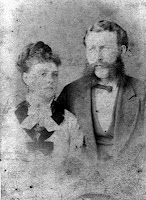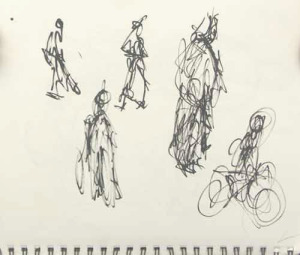Writing classes often advise emerging authors to give a lot of attention to all the senses. ‘Include smells,’ they say. ‘Include textures and sounds. Mention the taste of things.’ These tutors are right. Humans have five senses, and use them constantly, whether they are aware of the fact or not. Writing needs to suggest real life.
Beginning writers need to be very cautious with this aspect of writing, however: bombarding the reader with every single sensory notion in every scene, or giving too much information about a character’s experience of one, can have an off-putting effect. Are you sure your reader wants to know what every scene smells or sounds like? It can be over-kill to compare noises and aromas continually. It is much more effective to mention these things occasionally, and with a lot of thought and planning.
 Humans are, after all, very visual – and what they do while they read is build a mental ‘picture’ of what the author suggests. It is rarely a mental noise, or a mental smell! And this is where the literary arts have a similarity to visual arts such as photography or painting. Such artists suggest mental imagery that prompts the reader’s own store of memories and experiences. Words are as powerful as pictures in suggesting emotions such as fear, joy and exhilaration, and a few words are enough, just as a few strokes of charcoal in a sketch or a vague black and white photograph are sometimes enough to provoke a whole flood of memories.
Humans are, after all, very visual – and what they do while they read is build a mental ‘picture’ of what the author suggests. It is rarely a mental noise, or a mental smell! And this is where the literary arts have a similarity to visual arts such as photography or painting. Such artists suggest mental imagery that prompts the reader’s own store of memories and experiences. Words are as powerful as pictures in suggesting emotions such as fear, joy and exhilaration, and a few words are enough, just as a few strokes of charcoal in a sketch or a vague black and white photograph are sometimes enough to provoke a whole flood of memories.

A bleak landscape, a family group … they are images we all have in our heads, but they are not all necessarily identical. Reading a book, we tend to like suggestions much more than literal and minute descriptions, so that we can fill in the picture with our own imagination. A reader’s own thoughts play a very important part in the activity of taking in a novel, just as they do when they see a sketchy rendition of something that looks vaguely familiar.
The role of the author must be understood in this relationship between one who creates a story and the receptor of that narrative. It is a kind of dance, where one leads, but occasionally stands back to allow the other a very personal space in which to conjure pictures of their own.
Is this why reading is so satisfying? Readers often say they prefer the book to the movie that follows. Is it because the movie is not their own visualization, but that of the director?
Let me know what you think – how you like sensory aspects in what you read. If you are a writer, tell me how much prompting you feel your readers need to conjure a scene you create for them in their minds. Tell me whether you feel there is some sense in calling writing a visual art.
* * * * *
 Rosanne Dingli studied fine arts in the 1970s. She still paints, and finds it much easier than writing. Her newest novel, Camera Obscura, deals with visual arts such as photography and painting. For more about Rosanne Dingli, visit her website, or her blog.
Rosanne Dingli studied fine arts in the 1970s. She still paints, and finds it much easier than writing. Her newest novel, Camera Obscura, deals with visual arts such as photography and painting. For more about Rosanne Dingli, visit her website, or her blog.
[This article first appeared on Rosanne Dingli’s blog in April, 2011.]
[subscribe2]

Well said Rosanne. Finding the correct balance between too much and too little description is one of my biggest struggles as a writer. I tend not to give enough. And when I add it I often wonder whether I have hit the right note with it.
I find it interesting, too, to see how a character senses a particular scene, smell or such rounds out their personality. Since our sensory perceptions are such subjective experiences the subjectivity with which our characters encounter sensory input can tell us a lot about who they are.
Yes, Yvonne – making a character react in a certain way to some smell or noise is an indirect description, which makes the reader work a little harder.
But the imagined result is as much a figment of their imagination as it was of the writer's.
Exactly. So, often subtle is best. It allows the reader to insert themselves and so identify with the character in a more personal way. I think it aids the 'suspended disbelief' that engages the reader more fully. Not sure I have mastered it though. 🙂
Smell wasn't part of my aptitudes growing up (thanks to allergies, colds, bronchitis), so it never really makes it into my writing. Not surprisingly! I guess if you're a blind writer you shouldn't write about colors either…
I have a lot of respect and admiration for the way authors convey sensory reactions. Sometimes it's the simplest of phrases that do it. I remember a long time ago, at school, a friend of mine was often teased by her parents because when the sun was out, she would say, "I can hear the sun shining". I knew exactly what she meant, though!!
You are right.
Provide some details correctly.
And leave some space for the reader to insert their own memories and experiences.
I think I have a very mild synaesthesia, which can be very useful for metaphors or other figures of speech. Sounds, for example, will often have tactile qualities, or even visual ones. Like an angular guitar sound or a chalky voice. I'm pretty sure I incorporate these blurred sensations into my writing.
Thank you for sharing. Not to many people in your position are so gracious. Your article was very poignant and understandable. It helped me to understand very clearly. Thank you for your help.
bestdigitalcamerasreview.net
Great post. I tend to sometimes forget the senses, and that's where my best friend and beta readers "remind" me. Bless them!